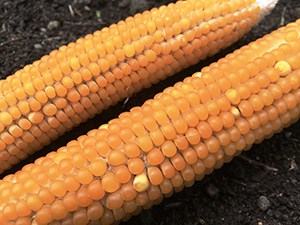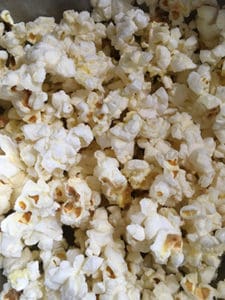By Bonnie Kirn Donahue, UVM Extension master gardener
Growing popcorn is a fun way to extend the summer corn season.

Popcorn can be harvested when the husks have started to dry and the kernels are shiny and hard.
If you are familiar with growing sweet corn, growing corn for popping is very similar. Make sure to select seeds that are intended for popping instead of fresh eating. If you dry and try to pop a variety like sweet corn, you may be disappointed by the outcome.
Popping corn takes over 100 days to reach maturity. So it is important to plant the corn early in the season, after the soil has warmed to at least 60 degrees Fahrenheit.
Corn is pollinated by wind. It is recommended that you plant corn in at least four rows for proper crosspollination. If you have ever eagerly husked corn in late summer and found uneven kernels on the ears, poor pollination could be one of the reasons.
In order to prevent crosspollination of corn varieties, plant only one variety of corn per season. However, if you really would like to plant multiple types of corn, you can stagger the planting of the varieties by a few weeks so that the pollination timing of each does not overlap.
Prior to planting, make sure that your soil has enough nutrients and organic matter to support your crop.
A soil test from the University of Vermont Agricultural and Environmental Testing Lab (pss.uvm.edu/ag_testing) can be helpful to give you the exact nutrient recommendations for your crop and soil type. The test also may suggest the best times to add fertilizer throughout the growing season.
Corn seeds can be planted very close together. After they are a few inches tall, you should thin your rows to as close as 6 inches between corn stalks. Space between rows can vary from 18-30 inches depending on your preferences.

Popcorn popped from corn grown in the author’s garden — a perfect way to extend the corn season.
Last year I experimented with growing corn in a low, 4-foot by 6-foot raised bed, and the results were surprisingly successful. You can grow the rows closer together because you don’t need space to walk in-between. I spaced my rows 12-14 inches apart.
One thing to keep in mind is that squirrels, raccoons and other animals also may be interested in your crop as much as you are. Consider planting a bit more corn than you need, planning to share with your furry neighbors. If they are too eager, you may want to consider electric fencing in the future.
Popcorn is ready to harvest when the husks have started to dry and the kernels are shiny and hard. After picking, remove the husks and place the ears in a dry place with plenty of airflow to complete the drying process.
After several weeks, the popcorn should be ready to eat. You can put the whole cob in a paper bag and microwave it until there are about 2-3 seconds between pop. This method might take some finessing.
Another option is to remove the kernels from the cob by hand. You can heat the kernels in a pot on the stovetop or in a popcorn maker. Add your favorite seasoning and enjoy!



